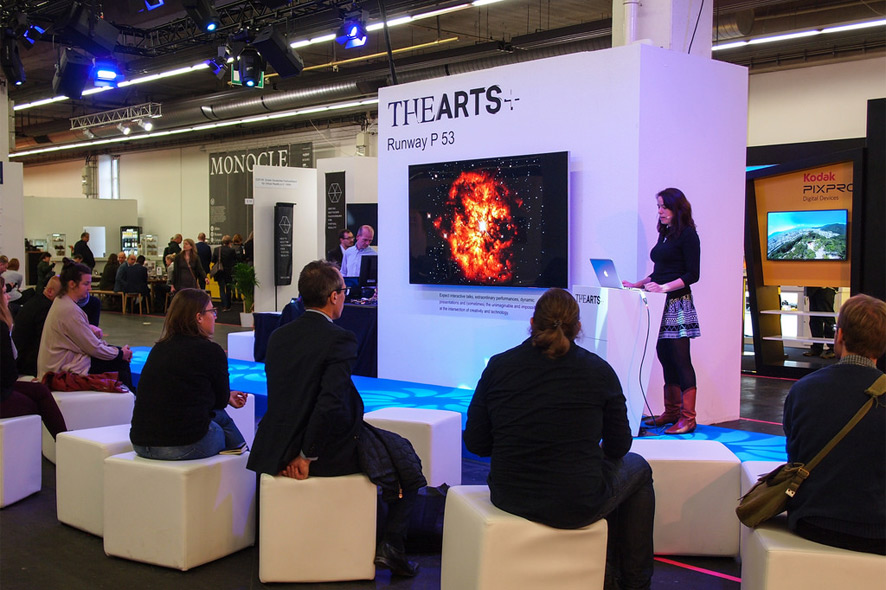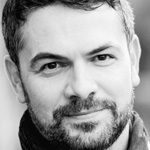With its 500+-year tradition, the Frankfurt Book Fair is the world’s largest publishing industry trade show, attracting over 275,000 visitors and 7,100 exhibitors annually. In 2016, this hub of the international book market took another giant step in the direction of art and technology by setting up a new platform oriented on exchange. THE ARTS+ premiered with a jam-packed lineup of workshops, labs and presentations in Hall 4.1 October 19-23. Ars Electronica was on hand too, represented by artists Aoife van Linden Tol and Sebastian Neitsch, two recipients of a residency under the aegis of the European art&science program. According to Holger Volland, vice president and member of the executive board of the Frankfurt Book Fair, there’s no doubt that digitization has now reached the business of art and culture. We talked to him about what (media) art and books have in common, and which topics occupied the focal point at this year’s edition of THE ARTS+.
“Five days full of books and ideas”—how does media art fit in at the Frankfurt Book Fair?
Holger Volland: I can cite lots of examples! The Van Gogh Museum, for example, has developed a sophisticated app to enable users to prepare for a visit to the museum, and to expand the visit on-site through the use of digital tools. This entails supplements in the form of texts, images and videos—which are nothing but modern versions of an exhibition catalog that is, in turn, a domain in which art and publishing are neighbors of long standing. Another instance is artist Oliver Laric, who often works with 3-D scans and 3-D printing. In collaboration with the Collection Museum and Usher Gallery in Lincoln, UK, he’s made several of their works of art available to all comers in the form of 3-D printed copies. Busts of Beethoven, Dante and Einstein were replicated as three-dimensional models and then propagated online.
I don’t think it takes too much imagination to come up with promising business models for publishers, art institutions, and artists when art is digitized. Nor is it all that difficult to imagine that free—and often copied—content could pose a serious challenge to the art world just as it has been for the music and publishing industries.
“When cultural assets and creative works are digitized, this makes available content from which new content products can be developed. What’s emerging here at present is a new ecosystem populated by cultural institutions, high-tech firms, project producers and content agencies.”
What we need now is a debate about how we want to deal with the rapidly proliferating intellectual property of digital cultural content. Plus, we have to develop new business models pertaining to these new digital assets. Publishing houses possess comprehensive experience in developing content and can thus provide valuable support. Otherwise, the answer to these various questions—what’s going to happen to the 3-D architecture models of the late Zaha Hadid, the TATE’s digitized collection, the digital renderings for 3-D printed fashion gear—will all remain up in the air.

Aoife Van Linden Tol during her Espresso for the Mind presentation. Credit: Martin Hieslmair
In 2016, THE ARTS+ staged a fair of its own within the Frankfurt Book Fair. Why was this new platform created? And why now?
Holger Volland: In the wake of the music, film and publishing industries, digitization is now slowly but surely approaching the business of art and culture. Museums, galleries and cultural institutions now have to face the same issues that these other creative sectors have confronted: How do you earn money when potential visitors no longer have to visit a museum to see a van Gogh, a Monet or a Picasso? After all, you can feast your eyes on all of it online, and do it free-of-charge! This is the precise point of departure of THE ARTS+.
Digital production processes like 3-D scanning, 3-D printing, digitizing Rembrandt’s painting style—google the “Next Rembrandt” project—and 360° cameras are only a few examples of new tools that make it possible for cultural and creative production to occur anywhere, and that’s what we wanted THE ARTS+ to illustrate.
Nevertheless, just as was previously the case in the publishing industry, this Digital Revolution is also raising many questions. What’s the position of artists and copyright owners with respect to digital copies? What does this trend mean for established, creative producers and providers? Which cities will prevail and become the hubs of these new creative sectors? These are the issues we want to discuss with all stakeholders, so we think the time has come for a platform like THE ARTS+.

Sebastian Neitsch of Quadrature at the Frankfurt Book Fair. Credit: Martin Hieslmair
Speaking of which: what’s up with the plus at the end of THE ARTS+?
Holger Volland: We define THE ARTS+ as a business incubator for creatives and the arts. THE ARTS+ is a platform to nurture digital cultural assets’ potential to achieve a breakthrough. First and foremost, the accent is on new forms of copyrighting and licensing—so, in this context, the plus stands for the value added in this way.
This year’s motto of THE ARTS+ was “The Business of Creativity.” You were in attendance and talked about this to lots of participants and attendees. What would you say is happening in the creative sector in Autumn 2016?
Holger Volland: One of the most virulent topics at THE ARTS+ was definitely virtual reality. On the Fair Weekend, THE ARTS+ Salon was a veritable hotbed of virtual reality experiences. In cooperation with the EDFVR–First German Business Association for Immersive Media, we set up a space in which fairgoers could experience films, VR games & art installations. On Fair Friday and Saturday, THE ARTS+ Runway venue hosted an interactive presentation of the KODAK Pixpro 360/4K Action Cam that showed how 360° VR videos come about. We will certainly be dealing with this topic a lot more in the days and years to come.
Do you already have ideas and plans for THE ARTS+ 2017 at the Frankfurt Book Fair?
Holger Volland: This year, THE ARTS+ enabled people to experience digital content, and staged a sort of innovation show that demonstrated what’s technically feasible right now. In 2017, we intend to shed more light on new business models and the various copyrights and licenses that arise in this area. The core of THE ARTS+ is hosting a licensing marketplace for new digital cultural assets. Museums and collections will increasingly occupy the focal point of THE ARTS+ and showcase the digital assets they’re offering. There will definitely be a lot of technology once again, just like there was this year—also in the field of digitized illustration.
NOTE: The next Frankfurt Book Fair is set for October 11-15, 2017. As soon as details are available, they’ll be posted to www.buchmesse.de. For a close-up look at THE ARTS+, please visit theartsplus.com.

Holger Volland is vice president of the Frankfurt Book Fair and a member of its executive board. He is responsible for international business development, and heads the book fair’s office in Beijing as well as its events and special sales division. He and Christiane zu Salm jointly launched THE ARTS+.
